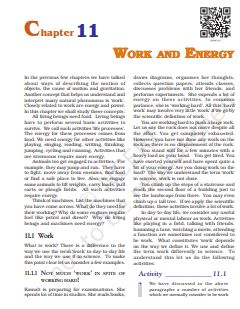‘NCERT Solutions for Class 9 Science Chapter 11‘ PDF Quick download link is given at the bottom of this article. You can see the PDF demo, size of the PDF, page numbers, and direct download Free PDF of ‘Ncert Class 9 Science Chapter 11 Exercise Solution’ using the download button.
NCERT Class 9 Science Textbook Chapter 11 With Answer PDF Free Download

Chapter 11: Work and Energy
11.1 Work
What is work? There is a difference in the way we use the term ‘work’ in day-to-day life
and the way we use it in science. To make this point clear let us consider a few examples.
11.1.1 NOT MUCH ‘WORK’ IN SPITE OF WORKING HARD!
Kamali is preparing for examinations. She spends a lot of time on her studies.
She reads books, draws diagrams, organizes her thoughts, collects question papers, attends classes, discusses problems with her friends, and performs experiments. She expends a lot of energy on these activities.
In common parlance, she is ‘working hard. All this ‘hard work’ may involve very little ‘work’ if we go by the scientific definition of work.
You are working hard to push a huge rock. Let us say the rock does not move despite all the effort. You get completely exhausted. However, you have not done any work on the rock as there is no displacement of the rock.
You stand still for a few minutes with a heavy load on your head. You get tired. You have exerted yourself and have spent quite a bit of your energy.
Are you doing work on the load? The way we understand the term ‘work’ in science, work is not done.
You climb up the steps of a staircase and reach the second floor of a building just to see the landscape from there.
You may even climb up a tall tree. If we apply the scientific definition, these activities involve a lot of work. In day-to-day life, we consider any useful physical or mental labor as work.
Activities like playing in a field, talking with friends, humming a tune, watching a movie, and attending a function are sometimes not considered to work.
What constitutes ‘work’ depends on the way we define it. We use and define the term work differently in science. To understand this let us do the following activities.
11.1.2 Scientific Conception of Work
To understand the way we view work and define work from the point of view of science, let us consider some situations: Push a pebble lying on a surface.
The pebble moves through a distance. You exerted a force on the pebble and the pebble got displaced.
In this situation, work is done. A girl pulls a trolley and the trolley moves through a distance. The girl has exerted a force on the trolley and it is displaced.
Therefore, work is done. Lift a book through a height. To do this you must apply force. The book rises up.
There is a force applied to the book and the book has moved. Hence, work is done. A closer look at the above situations reveals that two conditions need to be satisfied for work to be done:
(i) a force should act on an object, and
(ii) the object must be displaced.
If any one of the above conditions does not exist, work is not done. This is the way we view work in science.
A bullock is pulling a cart. The cart moves. There is a force on the cart and the cart has moved. Do you think that work is done in this situation?
| Author | NCERT |
| Language | English |
| No. of Pages | 14 |
| PDF Size | 1154 KB |
| Category | Science |
| Source/Credits | ncert.nic.in |
NCERT Solutions Class 9 Science Chapter 11 Work and Energy
1. When do we say that work is done?
Solution:
Work is completed whenever the given conditions are satisfied:
(i) A force acts on the body.
(ii) There’s a displacement of the body by applying force in or opposite to the direction of the force.
2. Write an expression for the work done when a force is acting on an object in the direction of its displacement.
Solution:
When a force F displaces a body through a distance S within the direction of the applied force, then the work done W on the body is given by the expression:
W = F × S
3. Define 1 J of work.
Solution:
1 J is the amount of work done on an object when a force of 1 N displaces it by 1 m along the line of action of the force
4. A pair of bullocks exerts a force of 140 N on a plough. The field being ploughed is 15 m long.
How much work is done in ploughing the length of the field?
Solution:
Work done by the bullocks is given by the expression:
W= F × d
Where,
Applied force, F = 140 N
Displacement, d = 15 m
W = 140 x 15 = 2100 J
Therefore, 2100 J of work is done in plowing the length of the field.
Work and Energy NCERT Textbook With Solutions PDF Free Download
